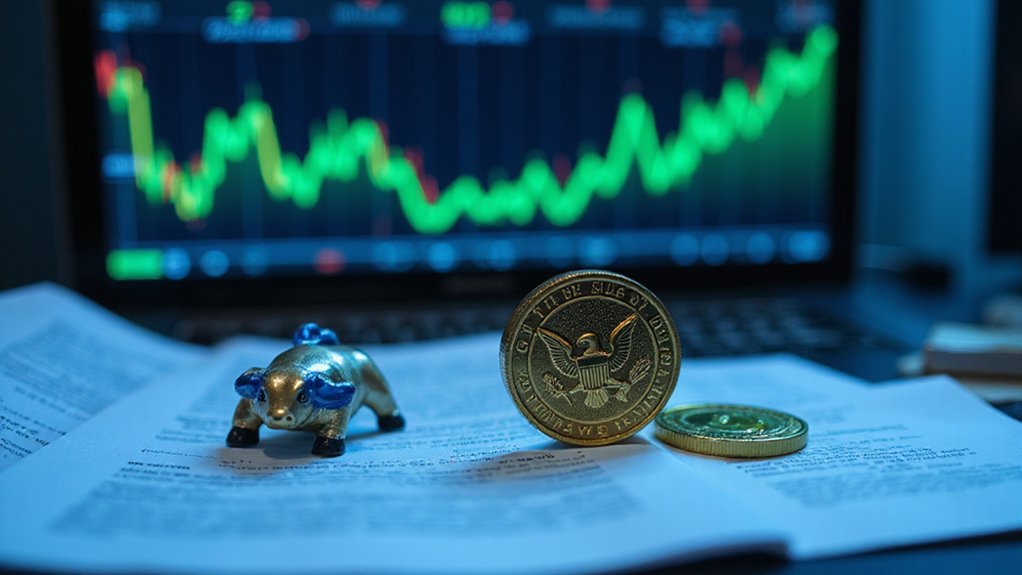A cryptocurrency bull market occurs when prices rise consistently, driven by positive investor sentiment. You'll recognize it when Bitcoin and other digital assets appreciate by 20% or more from recent lows. For the 2025 market, pay attention to Bitcoin's 2024 halving event, institutional adoption trends, and evolving regulations—all potential catalysts. Previous bull runs in 2013, 2017, and 2021 each established new all-time highs before correcting. Understanding these cyclical patterns can help you navigate the opportunities and risks ahead.

These powerful uptrends don't materialize randomly. They're typically driven by a confluence of factors: technological advancements improving blockchain functionality, favorable regulatory developments providing legal clarity, and macroeconomic conditions that highlight cryptocurrency's potential benefits.
Institutional investment decisions, like Tesla's $1.5 billion Bitcoin purchase in 2021, can validate the asset class. For Bitcoin specifically, halving events that reduce new supply often correlate with bull market beginnings. The four year cycle of Bitcoin halving events helps create predictable patterns of scarcity in the market.
History provides instructive examples of cryptocurrency bull markets. In 2013, Bitcoin surged from $13 to over $1,100. The 2017 bull run pushed the total cryptocurrency market capitalization to $830 billion. Most recently, 2020-2021 saw Bitcoin reach $69,000 while the total market exceeded $3 trillion in value. Each cycle has surpassed previous highs, though significant corrections inevitably followed.
While bull markets create opportunities, they present substantial risks. Heightened volatility can trigger sudden corrections that erase gains rapidly. Assets frequently become overvalued, forming price bubbles disconnected from fundamental utility. The increasing prices of Bitcoin typically drive investors toward memecoin alternatives that offer greater accessibility and community engagement. Technical patterns like Bullish Harami can help investors identify potential upward momentum during these periods.
Regulatory crackdowns remain an ever-present threat, and security risks increase as more valuable targets attract sophisticated hackers.
To navigate these periods effectively in 2025's market, you should consider implementing disciplined strategies. Dollar-cost averaging helps manage volatility risks. Setting predetermined profit-taking levels prevents emotional decision-making.
Diversifying across multiple cryptocurrencies reduces exposure to single-asset failures. Most importantly, staying informed about market developments allows you to anticipate shifts before they occur, positioning you to benefit from cryptocurrency's remarkable growth potential while minimizing downside risks.
Frequently Asked Questions
How Long Do Crypto Bull Markets Typically Last?
Crypto bull markets typically last 12-18 months, though they vary considerably.
You'll notice they often progress through distinct phases: 3-6 months of accumulation, 6-12 months of steady growth, followed by 2-4 months of parabolic price action.
Historical data shows the longest bull run extended nearly 3 years (2015-2017), while the shortest significant uptrend lasted about 6 months.
Bitcoin halving events frequently trigger these multi-year bullish cycles.
Can Government Regulations Abruptly End a Crypto Bull Run?
Yes, government regulations can abruptly end a crypto bull run.
You've seen this with China's 2021 ban, which caused a 50% Bitcoin drop, and the SEC's Ripple lawsuit that triggered a 63% XRP decline.
Regulatory crackdowns create market uncertainty, disrupting investor confidence and trading momentum.
When major economies implement restrictions on crypto activities, exchanges, or tokens, the rapid sell-offs can halt positive market trends almost immediately.
Should Beginners Invest During a Crypto Bull Market?
Beginners can invest during a crypto bull market, but you'll need caution.
Start with small amounts of capital and focus on established assets like Bitcoin.
Bull markets amplify both opportunities and risks, including market volatility and predatory schemes targeting newcomers.
Implement dollar-cost averaging to mitigate price fluctuations.
Remember, bull markets eventually correct, so don't invest funds you'll need short-term.
Research thoroughly and ignore FOMO-driven decisions.
What Technical Indicators Predict the End of a Bull Market?
You can identify bull market endings through several technical indicators.
Watch for death crosses when the 50-day MA drops below the 200-day MA, signaling trend reversal. RSI readings persistently above 70 suggest overbought conditions, especially with bearish divergence.
Declining Bitcoin dominance below 40% often indicates late-cycle euphoria.
Pay attention to diminishing trading volume despite price increases and extreme greed readings on sentiment indexes, which frequently precede major downturns.
How Do Altcoins Perform Compared to Bitcoin During Bull Markets?
Altcoins typically outperform Bitcoin during bull markets, delivering significantly higher returns due to their smaller market capitalizations.
Historical data shows altcoins returned 344x versus Bitcoin's 26x in the 2015-2017 cycle's second half.
You'll notice altcoins follow Bitcoin's price movement but with more dramatic swings.
This amplified performance comes with greater volatility and risk.
Altcoin seasons usually emerge after Bitcoin's initial surge when investors seek higher-growth opportunities with increased risk appetite.
References
- https://101blockchains.com/crypto-bull-run-2025/
- https://transak.com/blog/what-is-a-crypto-bull-market
- https://www.finextra.com/blogposting/23045/what-is-a-bull-market-in-cryptocurrency
- https://trustwallet.com/blog/announcements/crypto-bull-market-2025-what-to-expect
- https://osl.com/academy/article/what-is-a-bull-market-and-how-can-you-identify-one
- https://guarda.com/academy/crypto/what-is-a-bull-market/
- https://forumpay.com/blog/cryptoworld/are-we-in-a-crypto-bull-market/
- https://www.bitpanda.com/academy/en/lessons/what-is-a-bull-market
- https://koinly.io/blog/bull-market-strategies/
- https://www.cointracker.io/blog/crypto-bull-runs





